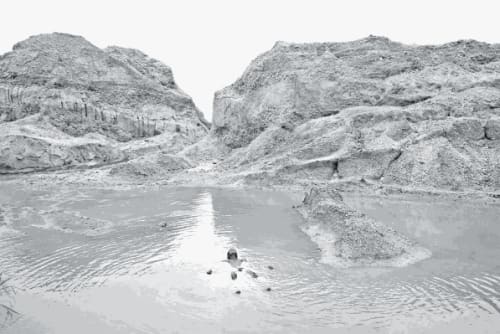There is nothing new about science fiction containing an under-lying social message. An exhibition of photographs, prints, and video art that evokes a sci-fi aesthetic and sounds a warning siren for urgent social, political, and ecological issues in South Asia does, however, give one pause for thought. Bangladesh-born Munem Wasif’s solo exhibition “Jomin o Joban—a tale of the land” opened with a series of monochrome, light-gray landscapes of barren mountain passes and scree that brought to mind an extraterrestrial terrain such as the desolate moonscape of Anarres in Ursula K. Le Guin’s 1974 novel The Dispossessed. Save for the occasional trace of movement or activity, for instance a leftover industrial pipe, tire tracks in the gravel, or a rare human figure, still and indifferent to the bleak surroundings, the photographs appeared to depict a timeless realm. And not only timeless, but placeless, as the series title, “Land of Undefined Territory,” 2016, suggests. In reality, they were taken in the no-man’s-land between India and Bangladesh, where farmers sometimes work on a temporary and illegal basis as low-wage laborers between harvests.
Equally upending any clichéd understanding of Bangladesh as a place of natural ecosystems was the series of cyanotype prints “Seeds Shall Set Us Free,” 2016–. What appear to be fragments of a meteorite, glowing fish tendrils, or neon insect wings are set among images of carefully arranged rice grains. In contrast to the apparent otherworldliness of “Land of Undefined Territory,” the triangulation of land, labor, and rice more clearly directed the viewer’s attention toward key moments in the region’s history. This was backed up by the industrial tools, photographs of mills, and balls of jute in an anthropological-looking installation, Untitled, 2017, which seemed otherwise somewhat out of key with the rest of the work on view. As one of the main exports of the British Empire, jute was often grown in place of rice. This was one of the contributing factors to the Bengal famine of 1943, which killed between one million and three million people. Likewise, the Neel Bidroho, or Indigo Revolt, took place in 1859 after British traders forced farmers to grow indigo (evoked in this exhibition by the blue of the cyanotypes) instead of rice. Through his largely abstracted and alien-looking artworks, the artist thus asks us to reconsider the enduring legacies of colonialism, from the creation of borders and the exploitation of workers to the destabilizing of traditional agriculture and the loss of indigenous knowledge systems.


